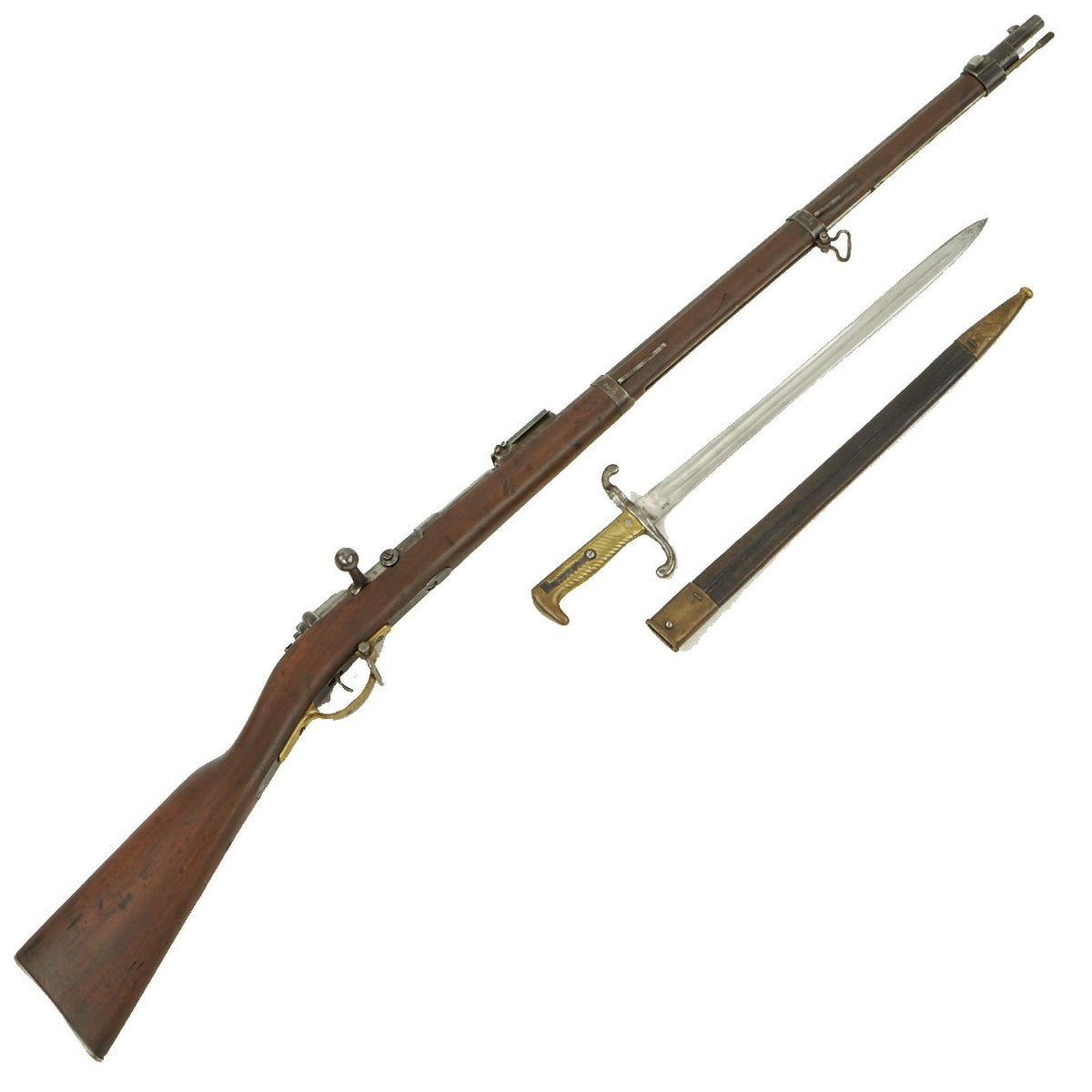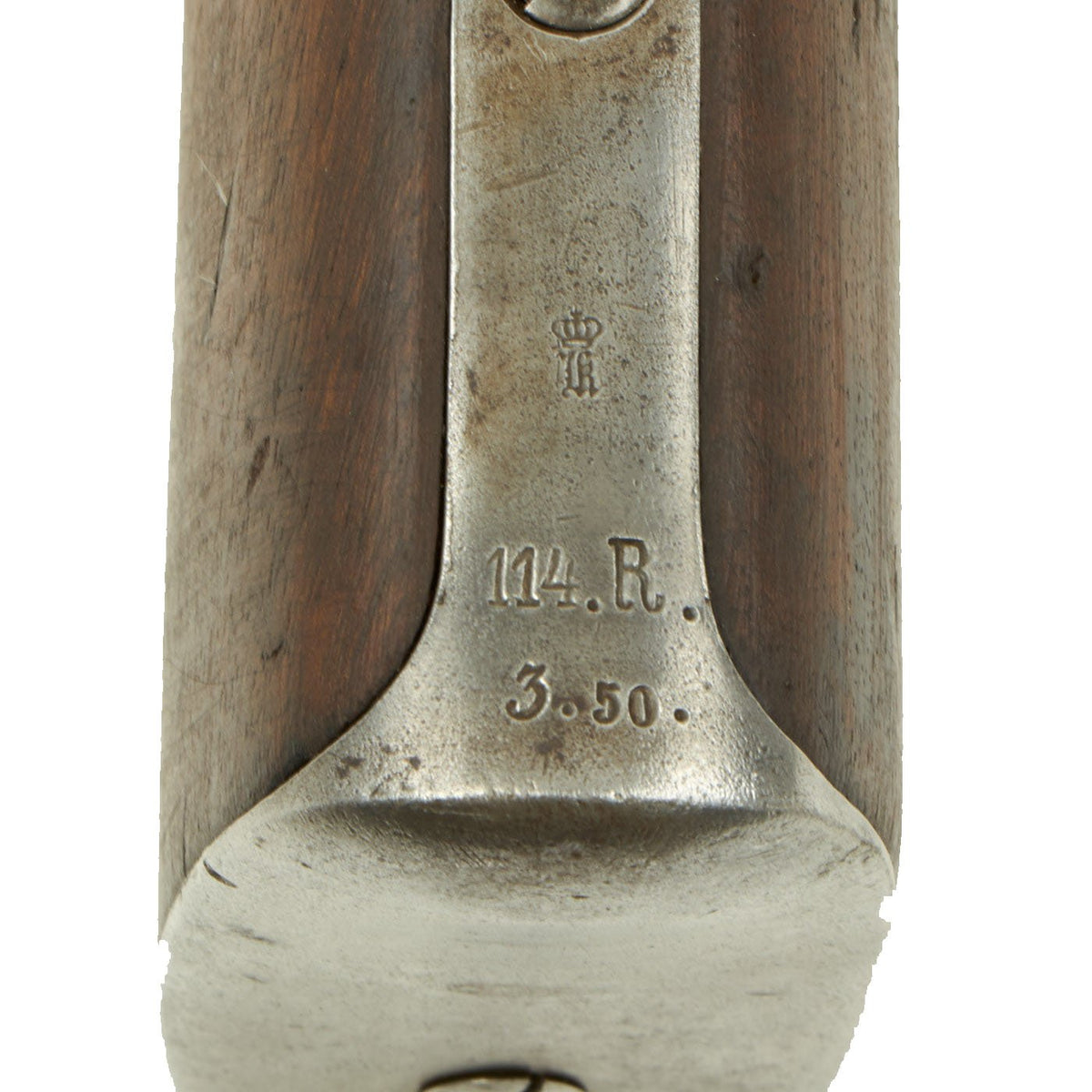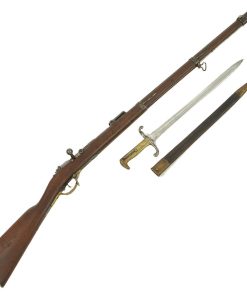Original German Mauser M1871 Rifle by Danzig Arsenal dated 1883 with Bayonet & Scabbard – Serial 3102 Original Items
$ 1.995,00 $ 498,75
Original Item: Only One Available. This is a nice example of the Mauser Model 1871 Infantry Rifle, manufactured by Danzig Arsenal in what was then part of the German Empire. It is covered with Imperial German inspection and acceptance markings, even on the wood stock. It bears serial number 3102 on the barrel, receiver, bolt, nose cap, and both barrel bands, while other parts are non matching.
The receiver is dated 83. 1883 and still has traces of the I. G. Mod. 71 marking on the opposite side in German “Black Letter” type. This stands for Infanterie Gewehr (Infantry Rifle) Model 71. The top of the barrel nocks form is marked Crown over DANZIG, for the Prussian (and later Imperial) arsenal in the Baltic Sea port city of Danzig, which is today known as Gdańsk, Poland. Below this is a faint Crown over FW proof for Kaiser Wilhelm I, who used the F.W. monogram.
There also is the CROWNED E / L G / * in an Oval proof on the nocks form, from Liège, Belgium, a major European gun making city. The “Tower of Liège” proof is also seen on the receiver, barrel, and most bolt components. We believe that this means the rifle was refurbished in Belgium, possibly for export sale, at some point after production. It was made in 1883 originally, just one year before being made obsolete by the Model 1871/84, which would have made it a prime candidate. It also may have been refurbished for use as a rear echelon / reserve weapon for WWI.
The butt plate tang on this rifle is regimentally marked with 114. R. 3. 50, for the 114th (6th Baden) Infantry “Emperor Frederick III” Regiment, raised on 26 October 1867 and garrisoned at Konstanz. This unit was part of the XIV Army Corps.
The Rifle comes complete with cleaning rod and is in good condition overall, though the cleaning rod is now relatively loose in the channel. Interestingly, it has a brass trigger guard installed. The rifle still has both sling swivels intact. The exterior metal finish shows years of polishing, and is now all dull steel, with evidence of light peppering in the past. The bore is in very good condition, with crisp lands and grooves and a mostly bright finish, so it was not fired much at all. The rifle cycles and dry fires correctly, an has an intact firing pin.
The stock looks very nice, though it has been arsenal reconditioned, which has made the original proof marks somewhat faint. It has a lovely color and great grain, with the usual dents and other marks from years of handling and service.
The rifle comes complete with an excellent example of the Mauser Model 1871 rifle bayonet with brass hilt, compete with the original brass-fitted leather scabbard. The bayonet is in good condition, and is marked on the rear of the blade with (Crown) / W/ 73, indicating acceptance in 1873 during the reign of German Emperor Wilhem I, who reigned 1871-1888. The bayonet is in great shape, as is the scabbard, and both have regimental designations on them, 40. L.R.E. 1. 51 on the bayonet and 55. R.E. 4. 103. on the scabbard.
The blade ricasso is maker marked ALEX COPPEL / SOLINGEN, indicating manufacture by Alexander Coppel & Co. located in the legendary “City of Blades”, Solingen. This company manufactured bayonets for many years and up through WWII under the name Alcoso. Sadly, as the Coppel family was Jewish, they saw their company stolen from them and “Aryanized” during WWII by the NSDAP. For more information on this maker please see J Anthony Carter’s excellent work GERMAN KNIFE AND SWORD MAKERS.
Overall this is a great example of a German Mauser model 1871, complete with the correct bayonet and lots of research potential in the markings. The perfect addition to any German Mauser collection!
History of the Mauser 1871
Adopted as the Gewehr 71 or Infanterie-Gewehr 71, or “Infantry Rifle 71 (“I.G.Mod.71” was stamped on the rifles themselves) was the first rifle model in a distinguished line designed and manufactured by Paul Mauser and Wilhelm Mauser of the Mauser company and later mass-produced at Spandau arsenal.
Paul Mauser developed his bolt-action rifle from 1866 to 1871. During 1870-71 trials with many different rifles took place, with the “M1869 Bavarian Werder” being the Mausers’ chief competitor. The Mauser was provisionally adopted on 2 December 1871, pending the development of an appropriate safety. With support from the government’s Spandau arsenal, the improvements to the safety mechanism were completed and the rifle was formally accepted on 14 February 1872 as Infantry Rifle Model 1871 by the German Empire excluding Bavaria. The action was not based on its predecessor, the Dreyse needle gun which had seen service during the Franco-Prussian War of 1870-71, and which was found to have a number of weaknesses.
The now well known Mauser “wing” type safety lever was developed for the Gewehr 71. The Gewehr 71 is a conventional looking bolt action chambered in 11mm using black powder cartridges. The action included only a bolt guide rib as its single locking lug, locking forward of the receiving bridge. The original design was a single-shot. The design was updated in 1884 with an 8-round tubular magazine designed by Alfred von Kropatschek, making this Germany’s first repeating rifle. This version was designated the Gewehr 1871/84. A version of this repeater was adopted by the Ottoman Empire. Designated the M1887, it differentiated from the M71/84 in that it had a side mounted cleaning rod, a second locking lug on the rear of the bolt, and it was in caliber 9.5×60mmR, which Paul Mauser touted as the most efficient (black powder) cartridge. In the early 20th century a few were converted to 7.65×53mm smokeless by the arsenal in Ankara.
Specifications (Rifle):-
Year of Manufacture: 1883
Caliber: 11x60mmR Mauser
Cartridge Type: Centerfire Cartridge
Barrel Length: 33.5 inches
Overall Length: 53 Inches
Action type: Bolt-Action
Feed System: Single Shot
Specifications (bayonet):-
Blade Length: 18 1/2″
Blade Style: Single Edge with Fuller
Overall length: 23 1/2“
Crossguard: 4 5/8”
Scabbard Length: 19 1/2″
NOTE: International orders of antique firearms MUST be shipped using UPS WW Services (courier). USPS Priority Mail international will not accept these.
Fast Shipping with Professional Packaging
Thanks to our longstanding association with UPS FedEx DHL, and other major international carriers, we are able to provide a range of shipping options. Our warehouse staff is expertly trained and will wrap your products according to our exact and precise specifications. Prior to shipping, your goods will be thoroughly examined and securely secured. We ship to thousands clients each day across multiple countries. This shows how we're dedicated to be the largest retailer on the internet. Warehouses and distribution centres can be located throughout Europe as well as the USA.
Note: Orders with more than one item will be assigned a processing date depending on the item.
Before shipping before shipping, we'll conduct a thorough inspection of the items you have ordered. Today, the majority of orders will be delivered within 48 hours. The delivery time will be between 3-7 days.
Returns
The stock is dynamic and we cannot completely manage it because multiple stakeholders are involved, including our factory and warehouse. So the actual stock may alter at any time. It's possible that you may not receive your order once the order has been made.
Our policy is valid for a period of 30 days. If you don't receive the product within 30 days, we are not able to issue a refund or an exchange.
You can only return an item if it is unused and in the same state as the day you received it. You must have the item in its original packaging.
Related products
Uncategorized
Armored Burgonet Helmet & Polearm from Scottish Castle Leith Hall Circa 1700 Original Items
Uncategorized
Uncategorized
Uncategorized
Angolan Rebel 1970s era 60mm Inert Display Mortar from Angolan Civil War Original Items
Uncategorized
Band of Brothers ORIGINAL GERMAN WWII Le. F.H. 18 10.5cm ARTILLERY PIECE Original Items
Uncategorized
Uncategorized
Uncategorized
Uncategorized
Uncategorized
Armoured Fighting Vehicles of the World: AFVs of World War One (Hardcover Book) New Made Items
Uncategorized
Uncategorized
Uncategorized
Uncategorized
Uncategorized
Uncategorized
Uncategorized
Uncategorized












































































